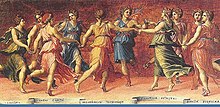Baldassare Peruzzi
| Baldassare Peruzzi | |
|---|---|

Muses Dancing with Apollo, fresco by Peruzzi
|
|
| Born |
Baldassare Tommaso Peruzzi 7 March 1481 Siena, Italy |
| Died | 6 January 1537 (aged 55) Rome |
| Nationality | Italian |
| Known for | Painting, Architecture |
| Notable work | Decoration of Villa Farnesina Palazzo Massimo alle Colonne |
| Movement |
High Renaissance Mannerism |
Baldassare Tommaso Peruzzi (7 March 1481 – 6 January 1536) was an Italian architect and painter, born in a small town near Siena (in Ancaiano, frazione of Sovicille) and died in Rome. He worked for many years with Bramante, Raphael, and later Sangallo during the erection of the new St. Peter's. He returned to his native Siena after the Sack of Rome (1527) where he was employed as architect to the Republic. For the Sienese he built new fortifications for the city and designed (though did not build) a remarkable dam on the Bruna River near Giuncarico. He seems to have moved back to Rome permanently by 1535.
He was a painter of frescoes in the Cappella San Giovanni (Chapel of St John the Baptist) in the Duomo of Siena.
His son Giovanni Sallustio was also an architect. Another son, Onorio, learned painting from his father, then became a Dominican priest in the convent of Santa Maria Sopra Minerva in Rome. He then stopped painting until requested by his superiors at San Romano di Lucca to paint the organ doors of the church.
Almost all art critics ascribe the design of the Villa Chigi in Rome, now known more commonly as the Villa Farnesina, to Peruzzi. In this villa, two wings branch off from a central hall with a simple arrangement of pilasters, and a decorative frieze on the exterior of the building [1]. Some of the frescoed paintings which adorn the interior rooms are by Peruzzi. One example is the Sala delle Prospettive, in which Peruzzi revived the perspective schemers of Melozzo da Forli and Mantegna, possibly under the influence of both. The walls of the room are painted so that when one stands toward the left, one has the illusion that one is standing in an open-air terrace, lined by pillars, looking out over a continuous landscape. The decoration of the façade, the work of Peruzzi, has almost entirely vanished, but it is documented by an anonymous French artist in a drawing, now held by the New York Metropolitan Museum of Art [2]. To decorate this villa on the Tiber many artists were employed, and just as the style of the villa in no wise recalls the old castellated type of country-house, so the paintings in harmony with the pleasure-loving spirits of the time were thoroughly antique and uninspired by Christian ideas. Raphael designed the composition of the story of Amor and Psyche as a continuation of the Galatea. On a plate-glass vault Peruzzi painted the firmament, with the zodiacal signs, the planets, and other heavenly bodies. The interior room has a striking use of illusionistic perspective [3]
...
Wikipedia
